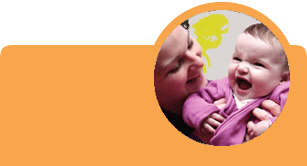
Interaction
What to expect
Typically, a child of this age will initiate interaction with others using verbal and non-verbal communication, e.g. words; eye contact; gesture; facial expression and body language.
It is important to be aware that, although some children may not yet be using a lot of spoken language at this stage, they may still be good at interacting and communicating by using non-verbal communication skills.
When to be concerned
Children who: lack awareness of others; do not show an interest in playing or interacting with adults or peers; do not respond to their name; or who show challenging behaviours are a cause for concern at this stage.
Watch out for children that show little interest in copying an adult or communicating at all, unless it is to gain something they want, such as a favourite toy or something to eat. These children may have limited use of non-verbal communication skills, such as eye contact and gesture, to engage with others and show little motivation to interact.
Listening and Attention
What to expect
At the age of 2, a child can typically maintain their attention for a short time on a motivating toy or a book. At this stage, children are also beginning to show interest in activities of an adult’s choice.
When to be concerned
A child who does not pay attention to an activity of their own choice for any sustained period and consistently flits between activities may be a concern at this stage.
It is important to confirm this through discussion with the child’s parents/carers, as sometimes being with a new person or in an unfamiliar setting can impact on a child’s ability to attend to an activity.
Play
What to expect
By 24 months, a child should be developing an interest in playing with smaller toys that represent real objects, such as toy animals and a farm, a doll and her clothes or a toy tea set.
Children of this age will begin to copy what they have seen adults or older children do with the real objects or with the toys, e.g. pretend to make a cup of tea or give adult some pretend food on a plate.
When to be concerned
Children of this age who show no interest in pretend play may be a cause for concern. It is important to discuss with carers how their children are playing with small world toys at home, e.g. are they picking them up and then throwing or biting them, rather than showing any constructive pretend play?
Play which is limited and repetitive may also be a cause for concern.
Understanding
What to expect
At the age of 2, children will typically be able to respond to simple directions in the absence of visual clues, e.g. if their carer calls to them from another room and asks ‘please bring your socks’, or if they are holding something and are asked to ‘put it on the chair’ with no pointing to support their understanding.
They should be able to point to an action picture on request, e.g. ‘show me the boy who is running’ and point to basic body parts on self, family and toys when instructed.
In addition, the child would typically follow a command containing 2 key words, e.g. ‘give the brush to dolly’ or ‘put the car in the box’ (bear in mind the need to have a choice of objects for each part of the instruction in order to demonstrate understanding of each of the key words).
When to be concerned
At 24 months, children who do not appear to understand everyday words e.g. ‘get your ball’ or ‘find your shoes’ are a concern. Children who do not seem to be able to understand and carry out simple instructions would prompt further investigation to determine if this is typical of them in every setting. Children who have difficulty understanding language may also echo what has been said to them.
It is important to be aware that children may mask their difficulties in this area by using routines, gestures, or watching others to succeed.
Expression
What to expect
Typically, a 2 year old child will be using 50 or more single words without adult prompting. They will be rapidly acquiring new words and often changes can be seen daily in the new words they use.
These new words are usually used first at a single word level, e.g., ‘teddy’; ‘more’, ‘dada’, however, children of this age will be beginning to use their words in simple two word sentences such as ‘more juice’, ‘mama car’ or ‘teddy hat’.
They will ask for drink, food and toys/activities, and will be starting to use questions, e.g. ‘what’s that?’; although their speech may not always be clear at this stage.
When to be concerned
Watch out for children at this age who are using less than 25 single words spontaneously. Children who have over 50 words, but who have never linked two words together are also a concern.
Speech Sounds
What to expect
At 2 years old, a child should be becoming easier to understand but will commonly still be difficult for strangers or non-immediate family members to understand, particularly when they are putting words together.
A 2 year old child will typically be using the sounds p, b, t, d, m, n and w in their speech.
When to be concerned
It is a concern if speech is frequently unintelligible to close family at this stage. It is, however, common for those other then family members to have difficulty with understanding what children of 27- 30 months are saying, as they would not be expected to be using the full range of speech sounds at this stage.
Eating & Drinking
What to expect
Most 2 year olds will tolerate a range of tastes and textures, although it is unlikely that they would be able to cope with very chewy meat yet, such as steak.
They should be able to finger feed – bite off food and chew it with reducing amounts of food spillage from the mouth.
They will typically be drinking form a spouted beaker without difficulty and possibly able to drink through a straw.
When to be concerned
It is a concern if a child is often choking, gagging and coughing during eating, especially if accompanied by persistent chest infections. This may be associated with a lack of ability to tolerate lumpy foods. A referral wouldn’t be indicated for a child who doesn’t like lumps in a sauce but who can eat other hard/lumpier foods e.g. crisps.
A very restricted diet is also a cause for concern, i.e. if the child will only eat a handful of foods and refuses to try anything else, particularly if they only like certain brands of food or only eat yellow food, for example. If a child has a restricted diet, look at this in relation to other aspects of their behaviour and development. There is no need to alert the Speech & Language Therapist for a faddy eater.
Voice
When to be concerned
If the child has a habitually hoarse voice, seek advice from the GP about a referral to ENT and consider requesting assistance from Speech and Language Therapy.
Special considerations : multi-lingual home environments
Parents should be encouraged to use their ‘mother tongue’ at home, even if two parents don’t share the same first language.
If the child is developing speech and language at the expected rate in their mother tongue, there is no need to request a Speech & Language Therapy assessment.
- Children who show a lack of interest in communicating with others
- Children who appear to look through people and are not aware of others
- Children who do not point to an object to direct another person to look at it
- Children who are not understanding simple instructions
- Children who do not ask or answer simple questions
- Children who are not yet using language to express their needs or draw your attention
- Children who have unusual or repetitive behaviours
- Children who have a very restricted diet, accompanied by other rigid behaviour patterns
- Children who have faltering weight gain accompanied by coughing, gagging and choking when eating and persistent chest infections (these children are unlikely not have been picked up at an earlier age)




